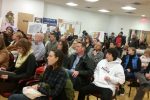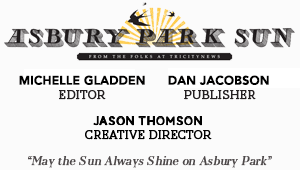Public Inputs Master Plan Reexamination Report Commentary
Jobs, Parking, Housing, Transportation, Arts & Culture Concerns Voiced
A two hour meeting held this past week allowed public input on the current Master Plan Reexamination Report being formulated by the city. The report is the first step in updating the existing plan, in pace since 2006.
Councilwoman Eileen Chapman opened the meeting by  saying “We’d like to have everyone’s input, everyone’s thoughts and ideas, as you know in the last 10 years we’ve seen a big change so you can imagine with the projects we know that are moving forward, there will be even bigger changes and transformations to the city.”
saying “We’d like to have everyone’s input, everyone’s thoughts and ideas, as you know in the last 10 years we’ve seen a big change so you can imagine with the projects we know that are moving forward, there will be even bigger changes and transformations to the city.”
The Master Plan Reexamination Report is being overseen by the city’s new Zoning Board Planners – Clarke Caton Hintz of Trenton. Principal Partner Michael Sullivan and Project Manager Elizabeth McManus led the meeting.

Sullivan explained that the reexamination process is establishing a to-do list for the master plan, which govern zoning. It sets the stage so that you can develop regulations for land use and zoning policies.
The areas of examination include land use; urban design; parking and circulations; housing; economic development; historic preservation; open space – parks, lakes and recreation; sustainability – alternative energy and transportation to stormwater runoff and infrastructure; community facilities; and visions and goals for the future.
The process began last summer and has included a review of the existing planning and land use regulations, five stakeholder 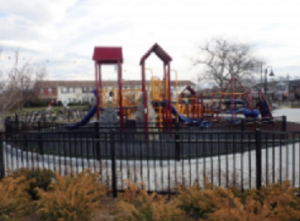 and two prior community engagement input meetings. Among the salient points unveiled is that the city’s demographic is changing. The 55 and older population is increasing, lending to a decrease in young families with children and growth in health care needs.
and two prior community engagement input meetings. Among the salient points unveiled is that the city’s demographic is changing. The 55 and older population is increasing, lending to a decrease in young families with children and growth in health care needs.
Sullivan said the examination also shows a demand for retail space and rental homes, in particular a need for affordable housing, not only in the classic definition but at levels between low income housing and luxury homes. There is a need to enhance public transit opportunities in order to leverage economic development.
Other points included an city-wide lighting plan, reducing the 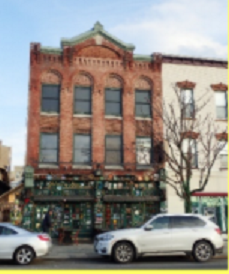 negative impact from entertainment venues, a complete streets and parking plan, the upgrade of Asbury Avenue as a gateway to the city, enhancing the open spaces areas, housing and code enforcement improvements, a streamlined development process, and how to maintain the essence of the city through proposed waterfront redevelopment area changes.
negative impact from entertainment venues, a complete streets and parking plan, the upgrade of Asbury Avenue as a gateway to the city, enhancing the open spaces areas, housing and code enforcement improvements, a streamlined development process, and how to maintain the essence of the city through proposed waterfront redevelopment area changes.
Thus far recommendations include updating current zoning laws to accommodate existing nonconforming uses that have developed over time; modernizing the Main Street commercial district to promote walk-ability; limiting auto rental uses to along Memorial Drive; creating and established arts district, public art plan, and artist live work spaces to help promote arts and culture in the city; creating guidelines for short term rental uses and an overall lan dlord rental database; public safety; a uniformed historic district guideline and city wide design standard that maintains the city’s existing character; sign regulations; and promoting retail and personal service businesses, recording studios, and mixed use structures along portions of Memorial Drive, Asbury and Springwood avenues.
dlord rental database; public safety; a uniformed historic district guideline and city wide design standard that maintains the city’s existing character; sign regulations; and promoting retail and personal service businesses, recording studios, and mixed use structures along portions of Memorial Drive, Asbury and Springwood avenues.
“The city ordinances have been in place for decades,” McManus said. “This reexamination report presents an opportunity to identify locations that are really in need of improvement.”
Below is a sampling of the public input comments in part:
Theresa Jones – said in making Asbury Avenue an arts destination creates no other alternative for residential parking areas. As far as parking, there never was parking in Asbury Park. In its heyday, people walked from the very far west 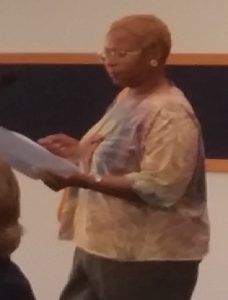 side…toward the beachfront. Density was much more increased than it is now in some areas. The shortsightedness in the plans that began in the early 1990s, was just that. Density was decreased by eminent domain. Those empty spaces that is over there on the east side were all viable affordable housing Those folks were literally kicked out of Asbury Park and it wall went down the tubes from there. Zoning changes were done in the 1990s without consideration to what existed. So, that confusion you have [pertaining to zoning laws] was a muck of confusion from a couple decades prior. Your historic, arts and culture district [is] Asbury, Mattison, and Bangs avenues, it’s not looking like that now because people were making changes without consideration of an urban plan.
side…toward the beachfront. Density was much more increased than it is now in some areas. The shortsightedness in the plans that began in the early 1990s, was just that. Density was decreased by eminent domain. Those empty spaces that is over there on the east side were all viable affordable housing Those folks were literally kicked out of Asbury Park and it wall went down the tubes from there. Zoning changes were done in the 1990s without consideration to what existed. So, that confusion you have [pertaining to zoning laws] was a muck of confusion from a couple decades prior. Your historic, arts and culture district [is] Asbury, Mattison, and Bangs avenues, it’s not looking like that now because people were making changes without consideration of an urban plan.
Dan Harris – spoke on the importance of placing public transportation stops throughout the west side, healthcare and jobs. When you start talking about  building these places, you have to talk about mixed usage where they may be a clothing store or a food store. We have enough restaurants in Asbury Park but we don’t have meat markets, we don’t have shoe stores, we don’t have grocery stores other than right here on Memorial Drive. Those things don’t exist so I don’t know how you can do a Master Plan and not look at the fact there is very little retail. Retail creates jobs and creates a multiplier effect by hiring in the neighborhood and spending in the neighborhood and letting the money go outside the neighborhood.
building these places, you have to talk about mixed usage where they may be a clothing store or a food store. We have enough restaurants in Asbury Park but we don’t have meat markets, we don’t have shoe stores, we don’t have grocery stores other than right here on Memorial Drive. Those things don’t exist so I don’t know how you can do a Master Plan and not look at the fact there is very little retail. Retail creates jobs and creates a multiplier effect by hiring in the neighborhood and spending in the neighborhood and letting the money go outside the neighborhood.
If we are talking about an older population, then there should be particular attention paid to that industry. I find nursing homes, healthcare facilities, rehabilitation facilities in Neptune, in Ocean Township, but how many of them do we have in Asbury Park.
Patricia ‘Tee’ Lesinski brought up brownfields and sustainability issues as it pertains to code enforcement of restaurant and vehicle washing in the street. I don’t why its not prevented. Improving recycling and waste management and trash receptacles because a lot of them are open and it’s hard to find one that is adequate.  They need to placed in proper areas. And changing flood hazard improvements that actually make the matter worse. I don’t if there is any part of your plan that addresses a cause and effect of what has been done and how you may be able to reverse the effects. Wesley Lake is an example because the box culvert was taken out and all the stormwater was reverted into the lake and not passed by so we have a lot of issues with damage to cars and property. Also, educational opportunities to invoke stewardship. And more collaboration and shared strategies between boards and committees within the city because people don’t communicate and one board does one thing which really shouldn’t be done because it violates what the other board is trying to enforce.
They need to placed in proper areas. And changing flood hazard improvements that actually make the matter worse. I don’t if there is any part of your plan that addresses a cause and effect of what has been done and how you may be able to reverse the effects. Wesley Lake is an example because the box culvert was taken out and all the stormwater was reverted into the lake and not passed by so we have a lot of issues with damage to cars and property. Also, educational opportunities to invoke stewardship. And more collaboration and shared strategies between boards and committees within the city because people don’t communicate and one board does one thing which really shouldn’t be done because it violates what the other board is trying to enforce.
Jerry Scarano I always thought Asbury Park was an economic engine for the region. My vision was Memorial Drive should be turned into corporate headquarters. Give them tax abatements to build as long as 25 percent of their workforce lives in town. That will bring pressure on the city to create affordable housing for middle income people because people will have to live in the city. Asbury Avenue and maybe First Avenue should become one way streets. Maybe Asbury Avenue should look like a boulevard with new apartment buildings and parking garages underneath them. A new parking garage should be out there where the land is cheap and when people come off the parkway it would be a place to park with a trolley system to ferry people around. Memorial Drive needs to be redone [as it pertains to stop lights and signs]. We have to be careful when we say high density, maybe on vacant land but not in taking old [historic] buildings down.
Conrad Neblett said of the 10 topics he was not sure where tourism fit in. I think it’s important to highlight tourism because we are a very unique town; 1.4 square miles of beach.
Charles Trott asked for more information on the arts and cultural approaches. There is an arts district already in Asbury and there is an arts commission related to public art in the city. When we talk about low and middle income housing, would that pertain to the west side, specifically the Springwood Avenue corridor. I’ve heard many plans, seen the drawings, beautiful drawings, but when are they coming? I just want you to think about it because they’re some people, I’m not trying to represent them but I probably am, that want to see something on Springwood with regard to these lovely plans. I need to see them implemented or hear more about it as it pertains to the southwest corridor.
that pertain to the west side, specifically the Springwood Avenue corridor. I’ve heard many plans, seen the drawings, beautiful drawings, but when are they coming? I just want you to think about it because they’re some people, I’m not trying to represent them but I probably am, that want to see something on Springwood with regard to these lovely plans. I need to see them implemented or hear more about it as it pertains to the southwest corridor.
Tracy Rogers said the landlord registry is a state-mandated ordinance that the city should be following. Before we talk about affordable housing, we are at 2015 and there is no 2015 affordable round plan as I understand it, the city doesn’t have it as I understand it. Right now when you take all these elements to talk about it, one I’d like to see it across the whole city; not looking at just project and developments. A lot of home in Asbury have back homes that we can used as assessments. Those can be put down and people can be given tax breaks by renovating those and creating affordable housing. How much affordable housing do we have on Cookman Avenue that has been built up in the past 10 years? We are looking at four to five projects [being proposed]. We need to put in ordinances right now because any of these obligations that we are accruing through credits, we are not being paid for. These are ordinances that we need to put in for builder’s trust that are building market rate and haven’t paid for it. We’ve lost all that money and the city become obligated to it. We need to make sure we get all these factors put in and put in quickly so we maximize an opportunity not to put this burden on the taxpayers in the city. Springwood Avenue need to be addressed right away in terms of what the details and the structure will be economically so that we don’t lose people and we start to create jobs for those people in that community. A full economic plan that looks to all the development that is going on should be added to creating jobs to these construction jobs that are going on right now, which we haven’t trained or gotten anybody ready for. Can we put zoning regulations for affordable housing into those elements.
Malcom Navis asked if the team was 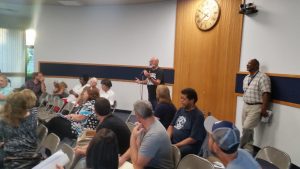 aware of the recent article that listed 38 bars in the 1.4 square mile city. They are coming here by the train loads, by the busloads and by car loads and vomiting and defecating and peeing and breaking the windows all down main street businesses. We want to know if that is going to be addressed.
aware of the recent article that listed 38 bars in the 1.4 square mile city. They are coming here by the train loads, by the busloads and by car loads and vomiting and defecating and peeing and breaking the windows all down main street businesses. We want to know if that is going to be addressed.
David Morton said his issue is when is enough going to be enough. You are talking building additional high rises, all these improvements along Memorial Drive but it has to at some point we really have to talk to quality of life. We have to make sure that whether you are old your young, the environment in which you are going to live in – the community, is a wholesome community and not just simply the buildings.
Werner Baumgartner, a 39 year resident and the city’s historian, said he’s been a staunch advocate of preserving the city’s character. Some things do concern me, I heard comments about gateways. Now, in the past when gateways were discussed, 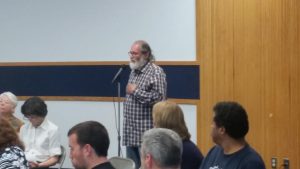 people were proposing physical structures like arches and things like that. I hope that is not what you are proposing. I want to speak against that now for the mere fact that things should be authentic. Asbury Park is extremely unique, it is extremely historic, and I think that anything that is done need to be authentic in character. So, greenery, landscaping, the original design from Bradley is certainly one of the key point. From an economic point of view, I haven’t heard much about the beachfront in your presentation. I understand that you really can’t do much with the current redevelopment plan, in terms of this process, but I think that the reexamination report certainly should mention that the Waterfront Redevelopment plan [WRA] should be renegotiated and reevaluated. When it was crafted many years ago, no one considered that Asbury would be a destination again. Asbury basically had been abandoned. To really follow the existing plan will be a detriment to those [iconic structures] that are left down there because they are currently zoned for other uses. In fact the [Stone] Pony could be demolished and turned into condo high rises. And I don’t think anybody would appreciate that or think that that is in the best interest of Asbury Park. That has me greatly concerned that there is a dichotomy between what is happening and evolving on the beachfront versus what’s actually on the books.
people were proposing physical structures like arches and things like that. I hope that is not what you are proposing. I want to speak against that now for the mere fact that things should be authentic. Asbury Park is extremely unique, it is extremely historic, and I think that anything that is done need to be authentic in character. So, greenery, landscaping, the original design from Bradley is certainly one of the key point. From an economic point of view, I haven’t heard much about the beachfront in your presentation. I understand that you really can’t do much with the current redevelopment plan, in terms of this process, but I think that the reexamination report certainly should mention that the Waterfront Redevelopment plan [WRA] should be renegotiated and reevaluated. When it was crafted many years ago, no one considered that Asbury would be a destination again. Asbury basically had been abandoned. To really follow the existing plan will be a detriment to those [iconic structures] that are left down there because they are currently zoned for other uses. In fact the [Stone] Pony could be demolished and turned into condo high rises. And I don’t think anybody would appreciate that or think that that is in the best interest of Asbury Park. That has me greatly concerned that there is a dichotomy between what is happening and evolving on the beachfront versus what’s actually on the books.

Louise Murray, a lifelong resident, said although she had no recommendations, she wanted to share some insight. I grew up here, there were four utilities here in Asbury Park. Main Street had every car dealership on it, we had four five-and-dime [stores], we had department stores on Cookman Avenue. I probably walked every street in this city. I was born and raised on the west side and Springwood Avenue was the most viable, it was like a little city unto itself. It had stores on the bottom and a lot people lived above the stores on Springwood Avenue. We had a medical arts building that housed a lot of doctors. We had four movie theaters [and a candy factory]. As far as the beachfront goes, it was just four months out of the year, that was it. I don’t know why everyone gets so hopped up about the beachfront. By the way, there was over 100 liquor license in this little town of a mile square. We had jazz clubs, and of course I took advantage of the jazz clubs when I was old enough. We had light industry on Memorial Drive and we had four grocery stores, and three swimming pools. We had it all in a one-mile square.

Rita Marano, a 50 year long resident, questioned why the Bradley Restrictions were not a part of the report, saying they take into consideration the streets, parks, lakes, and beachfront. As far as the last plan we had for the last 10 years, that is a disaster. You put a beer garden on Cookman Avenue and Lake, 700 people go there and there is no place to park. The work and live in space is a disaster. We don’t enough people in code enforcement to control these things. There are some people living on Main Street right now behind the stores and that’s a disaster. Springwood Avenue got all new sidewalks and lights. That’s going to get developed, in case anyone things it isn’t, it is. There are groups that want to come in and build housing. I’m not for more housing but that’s the way it is. And I’m not for taller buildings because they block the air. Bradley built those streets wide so that we can get the sea air. And now on Cookman Avenue, they want to build high rises and it will be like living in a tunnel. I don’t think that’s good for Asbury Park.
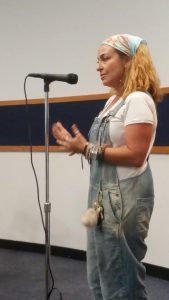
Daniele Fiori – The turnout here is amazing. There is so much feedback and there is all different people here. That’s what is so amazing about this town; all the different backgrounds and the diversity.
Rita Marano – There’s like 83 nonprofits in Asbury Park, I think that should be in the plan. There are 83 agencies to help the poor and we still have a high number of poor people. A lot of these nonprofits benefit themselves. Sisters of Mercy started with one building and now they have three buildings and their parking lot. Interfaith Neighbors, we gave them $3 million to build a senior center. We have one floor and they own the rest of it. They get 8 rentals and all the store rental on the bottom. These are nonprofits. This has got to stop, there are too many of them in this town.
Werner Baumgartner – I heard no mention of the school system in the presentation. I would like a recommendation that the current facilities be reevaluated in terms of the growing demographic in Asbury Park because you talked about recreational facilities and they have the biggest recreational facilities within a 5-10 mile radius. The track and field facilities, the ball park, being under school control limits its use completely. If the city wants to make use of that there will need be some give and take necessary between the school system and the administration.
Theresa Jones then said, I’d like to add one thing; a cautionary note. I think I can speak pretty clearly for the folks that look like me that are the majority of this city; black and brown folk. People have been disturbed and disgusted because it took four of five years for a silly little park to be done [on the west side] yet luxury high rises are being done overnight, literally on the east side. That disparity cannot continue. The group that is in here now is not representative of Asbury Park. We have to talk about this elephant in the room because this is foulness. I’m just putting this out there.
The process is being overseen by a steering committee comprised of members of stakeholders, Planning Board, governing body and business community members. The master plan reexamination report will be posted publicly prior to two future Planning Board meetings, at which time the public will be able to add more commentary and ask questions. Subsequent to that meeting, revisions will be made based on the Planning Board recommendations based on the planning board input meeting.
If you’d like to add your input prior to the Planning Board introduction, email masterplancomments@cityofasburypark.com.
—————————————————————-
Follow the Asbury Park Sun on Facebook, Twitter and Instagram.
The Asbury Park Sun is affiliated with the triCityNews newspaper.




